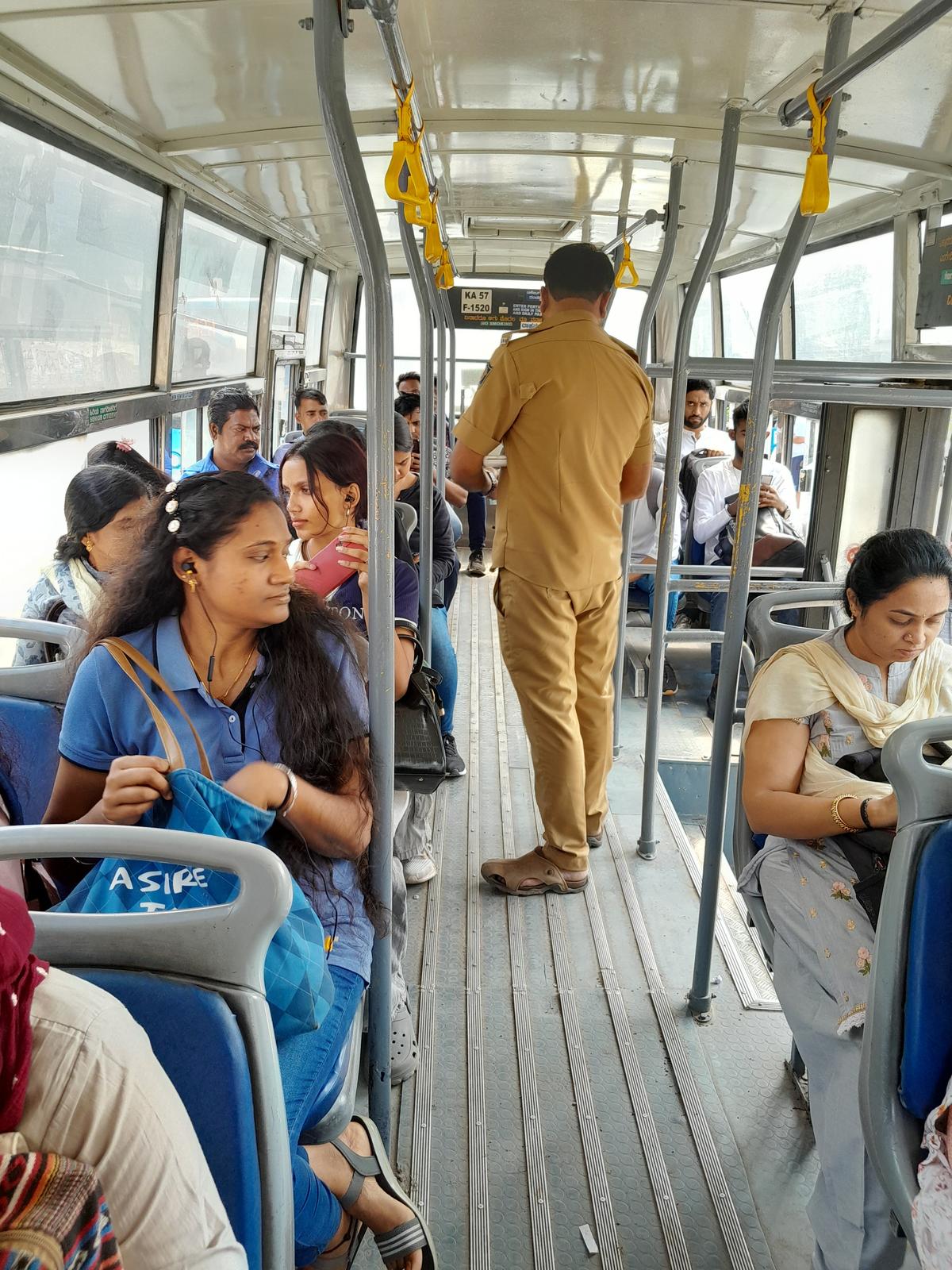Bengaluru Metropolitan Transport Corporation’s (BMTC) ten bus services that operate at 10-minute intervals in closed loops along a well-planned route network transport lakhs of commuters every month – a unique feeder bus service in the city’s HSR Layout has the potential to dramatically transform the way we think about public transport: Local, reliable, planned and sustainable. Can this intra-layout concept be improved?
In August, this system completed its first year, stamping a rare success for BMTC and public transport in general. Operating from 6pm to 11pm, the service covers all seven sectors of the HSR Layout along the 8.6 km route, with tickets priced at ₹10. Today, about 5,000 passengers take this feeder bus service every day, including women who are transported free under the Shakti scheme.
Although there are challenges such as using large buses on roads with tight turning radii, the system has a lot going for it. But the big question remains: Can this be replicated in other similar housing layouts across the city? The HSR Citizen Forum and the HSR Cyclists group, who have been fighting hard to activate the project for the past four years, are confident that it can be done.
Travel data analysis
But there are conditions. Launched in 2020 under the Directorate of Urban Land Transport (DULT) Sustainable Mobility Accord (SuMA), the HSR project cannot be implemented without research, data collection and analysis, a large publicity campaign and strong citizen participation. Government agencies such as DULT, BMTC, BBMP, citizens and volunteer activists should coordinate and lead joint action.
“The lessons have been very good in the way the structured project has been carried out. You can do this in other layouts if they follow the same approach in terms of a three-year stepwise journey. The involvement of active citizens of the locality is the secret recipe for success,” said Shashidhara K. , founder of the HSR Cyclists group.

HSR Layout BMTC feeder bus route.
Citizen involvement
Residents, he points out, understand pain points, congestion areas, turning radii at intersections, and demand and supply. “They can sit together with other stakeholders and plan all the loops and decide on the type of bus. Then the trial can be carried out for three months, the loop is adjusted again if needed,” he said.
Lack of buses, bus stops, low frequency and narrow local roads have forced lakhs of Bengalureans to resort to private vehicles or expensive autorickshaws and taxis for local travel. The HSR project has shown how well-designed feeder services with predictable schedules can make a big difference. But this does not happen quickly.
As Jayanthi Srikanth of HSR Citizen’s Forum recalls, preparations had already begun during the pandemic. “We conduct scientifically designed surveys for various demographics. We must ensure a good representation of all sections, low economic groups and people with disabilities are included. An extensive survey of 20-25 minutes is designed to understand the travel patterns of each family, ” she said.
In total, 1,023 people from 323 families were protected. “This is very important raw data on how people travel from point A to B, the different modes they use and what are the main modes and destinations of transport. Uploaded on the DULT website, this data shows almost zero public transport in the HSR Layout. Frequency there are very few buses, and people have given up because they can’t wait for an hour. It is clear that 96% of respondents want public transport,” explained Jayanthi.
Focus group discussions were held in order to analyze qualitative data. “We spoke to various groups to understand their pain points. Many parents from low-income groups and garment factory workers will walk long distances on uneven and broken roads. Those working in IT companies, schools and colleges say they spend Rs 50 up to 100 per day for cars or other modes.They will be happy if there is public transport.
These preparatory studies and meetings are critical to designing a feeder network that works for all sections. To replicate and expand, understanding the ground reality is essential. Mobility problems are common across cities, but local solutions require a good understanding of specific localities.

Operating from 6pm to 11pm, the service covers all seven sectors of the HSR Layout along the 8.6 km route, with tickets priced at ₹10.
Publicity campaign
The huge publicity campaign that followed after the introduction of the feeder system was not yet on the scale. Jayanthi explained, “For 67 days, we were on the campaign field in schools, colleges, temple gatherings, wherever people gathered. We had selfie frames at events, walkathons, and road games. Garbage pickup trucks played the message. which was recorded, reached all the houses for two weeks.
This bomb had the desired effect. After a few days of initial curiosity, commuters began to trickle in and increase in number. “Today, many people who go to Agara from HSR Layout, like those from Parangipalya, Mangammanapalya, Somasundarapalya and other areas take this feeder service. Many early employees who come to HSR take the bus after getting off the long route bus at Agara. There are 18 stops , and they dropped exactly at the location of his office,” said Shashidhara. Daily wage labourers, pass holder students and students of Mitra Jyothi blind school have now switched to this service.
Will it be sustainable?
But will the network last longer? Shashidhara is confident. “During peak hours, there is a demand for three buses at each stop, especially at Salarpuria junction, Agara junction and Mangammanpalya. We see a lot of people waiting from 7 to 9 in the morning, because of the number and number of rides, we feel there is no question about BMTC not getting profit from this service,” he said.
Heavy congestion on the Outer Ring Road has helped the service gain steady ridership. A resident of HSR Layout, Zahid, said that people from the Iblur area, wanting to avoid the congested Silk Road Junction, take the service to enter the HSR and enter the Hosur road ahead. But this is true only during peak hours, he added. To maintain the system throughout the day, he suggested small buses that do not cause congestion on the main roads.
Potential ‘metro boost’
However, the dynamics could change dramatically if the Airport Metro line from Silk Board Junction is commissioned. “After the station at HSR BDA Complex is opened, this feeder service will be a big hit. This service seems to be almost in preparation for Metro. When it starts in the next two years, these 10 buses will not be enough,” he said.
Independent mobility consultant Sathya Arikutharam believes that a fully functional feeder bus system will help as the Metro expands. But he also felt that minibuses and not large BMTC vehicles should drive the system. If BMTC does not have such buses, give space to private operators, he said. “Carve out eight sectors in Bengaluru, and in each sector, provide service level requirements for buses with a frequency of three minutes. Even the fare can be adjusted.”
As for BMTC, he said the company needed long overdue reforms to try local commutes using depots. “There are eight or nine depots. If everyone focuses only on nearby areas, the entire BMTC schedule can be repeated. So, if you are on HSR, there will be more intra-layout buses. But if you want to go out, say to Jayanagar, you take a bus that is further away at some interchange point,” he said.
Localized travel will definitely have more exchanges on the go. But, as Sathya says, “You’ll be able to travel short distances and longer distances, and just take the bus to corners and corners. That’s how all big cities are.”
Published – 15 October 2024 06:45 IST




